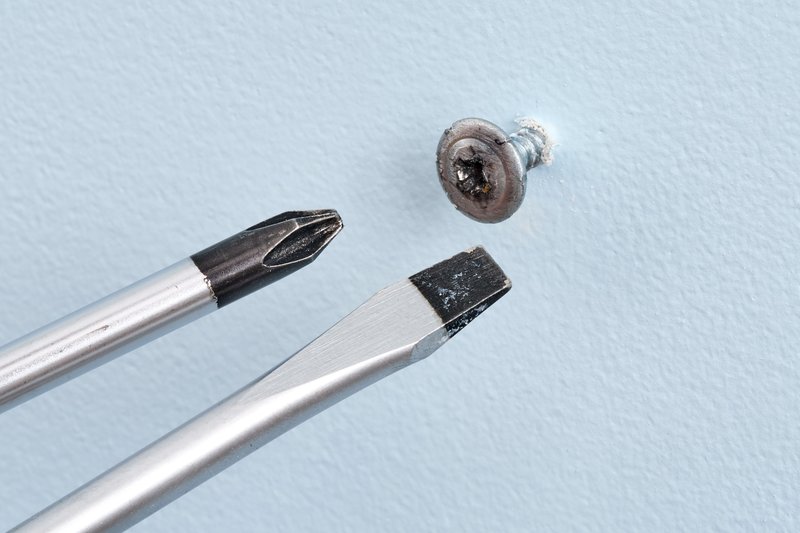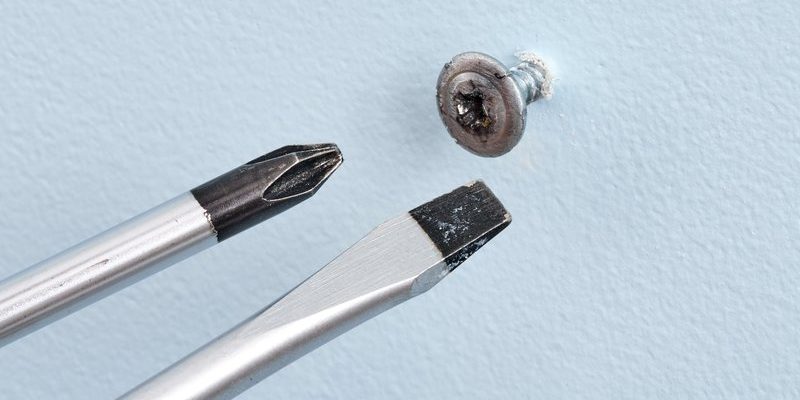
Let’s walk through the troubleshooting process. We’ll explore what a stripped screw head is, why it happens, and most importantly, how to fix it. This guide will help you regain control over your door hardware situation without losing your cool.
What Is a Stripped Screw Head?
A stripped screw head occurs when the edges of the screw’s head become worn down, preventing your screwdriver from gripping it properly. This wear can happen for various reasons, like using the wrong size screwdriver, applying too much force, or simply the screw aging over time. It’s often more than just an annoyance; it can derail your entire project.
You might be wondering how to identify a stripped screw head. If your screwdriver slips out or you see shiny metal where the grooves used to be, you’re likely dealing with a stripped screw. Think of it like a car tire with no tread. No matter how much you try to accelerate, you won’t get anywhere fast!
Why It Happens and How to Prevent It
Understanding the cause of stripped screw heads can help you prevent them in the future. Here are a few common reasons:
- Wrong-Sized Screwdriver: Using a too-small or too-large screwdriver can lead to slipping and stripping.
- Excessive Force: Applying too much pressure can damage both the screw and your tool.
- Old or Rusty Screws: Over time, screws can corrode or wear down, making them more prone to stripping.
Knowing these culprits is half the battle. Next time you tackle a door hardware project, make sure to use the right size screwdriver—ideally one that fits snugly. Regular maintenance on your screws and keeping an eye on their condition can also go a long way.
Tools You’ll Need
Before you dive into the fixing process, gather these essential tools:
- Screw Extractor Kit: These specially designed tools can grip and remove stripped screws with ease.
- Rubber Band: A simple rubber band can help increase friction for a better grip.
- Pliers: Needle-nose pliers can help grasp the screw if it’s protruding enough.
- Drill: A drill can be useful for creating a new groove in the screw head if needed.
Having the right tools can make a significant difference. You wouldn’t start a cooking project without a chef’s knife, right? Similarly, don’t start tackling stripped screws without the appropriate gear!
How to Remove a Stripped Screw
Now, let’s get down to business. Here’s a step-by-step approach to removing that troublesome stripped screw:
1. Assess the Situation: Look at the screw to determine how much of it is left sticking out. If there’s enough to grip, you might be able to use pliers.
2. Use a Screw Extractor: If the screw is too stripped for a regular screwdriver, consider using a screw extractor. These tools have a reverse thread that grips the screw as you turn it counterclockwise.
3. Try the Rubber Band Trick: Place a rubber band over the stripped screw head, then insert the screwdriver. The rubber band can provide extra grip to help you turn the screw out.
4. Drilling It Out: As a last resort, carefully drill a small hole in the center of the screw head. This can allow for better access with a screw extractor or give you a new groove to work with.
Remember, patience is key. Rushing can lead to more damage, so take your time with each step.
Alternatives to Removing a Stripped Screw
Sometimes, removing the screw isn’t the only solution. If you find yourself stuck, you might consider these alternatives:
- Cut a Slot: Using a Dremel tool, you can cut a new slot into the screw head for a flathead screwdriver.
- Replace the Hardware: If all else fails, you may need to replace the entire hardware piece. This can save time and prevent further frustration.
- Seek Professional Help: If you’re really stuck, calling a handyman or a professional service can be worth it. It might save you time and ensure a clean fix.
Each of these alternatives comes with its own pros and cons, so weigh your options carefully. It’s okay to ask for help when needed; after all, DIY doesn’t mean you have to do it all alone!
When to Call a Professional
There are times when tackling a stripped screw just isn’t worth the headache. If you’ve tried multiple methods and the screw won’t budge, it might be time to call in a professional. Here are some signs it’s better to seek help:
- If you’re not comfortable using power tools.
- If the surrounding hardware is damaged.
- If the screw is embedded deep into the material.
Sometimes, it’s best to let the experts handle it, especially if it means keeping your door and hardware intact!
Final Thoughts
Dealing with a stripped screw head when removing door hardware can be a real pain, but with the right knowledge and tools, it’s a challenge you can overcome. Whether you choose to use a screw extractor, the rubber band trick, or even call in a pro, there’s always a way forward.
Remember, each DIY project is a learning experience. You might face stripped screws again in the future, but hopefully, you’ll feel more prepared to tackle them head-on. So next time you’re faced with a stripped screw, take a deep breath and use these tips to get back on track!
